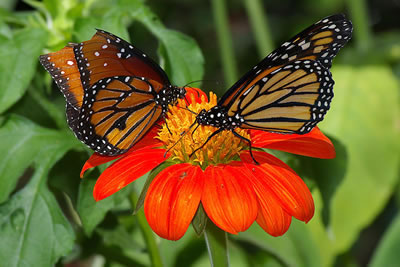
Description: The beautiful Monarch butterfly is perhaps the most recognizable and storied of all butterfly species. With its familiar black and orange patterned wings, the Monarch Butterfly is virtually unmistakable. Males and females are similar, but females have darker wing veins and males have a spot under each hindwing where pheromones are released. The average Monarch has a wingspan of about 4 inches.
Range: The Monarch Butterfly is found throughout most of North America, Madeira, the Canary Islands, and parts of Portugal and Spain. It is also found in Australia and New Zealand where it is called the Wanderer Butterfly.
Migration: The Monarch Butterfly is well known for its legendary migration. Monarchs in the eastern United States begin their lengthy migration to one of several points in the rainforests of Mexico in August, where they congregate in huge, colorful flocks. Only butterflies born at the end of the summer will embark on the two-month journey. Such butterflies enter the world in a non-reproductive state called diapause, and live much longer than reproductive monarchs (up to seven months). These butterflies reproduce in February or March after leaving their winter homes. The offspring of these monarchs return to the United States in spring. Monarchs in the western United States migrate to locations in central California.
Life Cycle: The female Monarch lays her eggs in late winter, spring, or early summer. When the larva hatches, it immediately eats its egg case and begins feeding on Milkweed. The caterpillar soon spins a silk pad on a leaf or twig and hangs upside down in a "J" formation, as its jade green chrysalis forms around it. The butterfly forms inside the chrysalis and emerges in about two weeks and feeds on a variety of flowers including milkweed, goldenrod, and red clover.
Defense: The Monarch Butterfly develops an effective defense from the milkweed it feeds upon. Its poisonous nature is advertised to would-be predators in the forms of its bright orange and black coloration. |